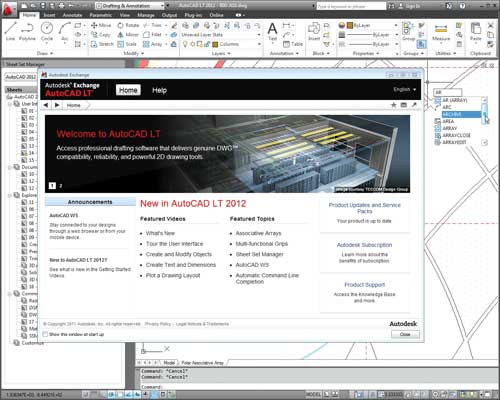Latest News
December 4, 2001
By David Cohn
Autodesk recently began shipping AutoCAD 2012, the 26th major release of the world’s most popular CAD program. For more than a dozen years now, AutoCAD has had a three-year development cycle. Every three years, Autodesk makes changes to its DWG drawing file format, which then supports the next round of additions to its venerable flagship product. The file format changed last with the release of AutoCAD 2010. If the cycle continues, AutoCAD 2012 marks the last version to use the 2010 file format.
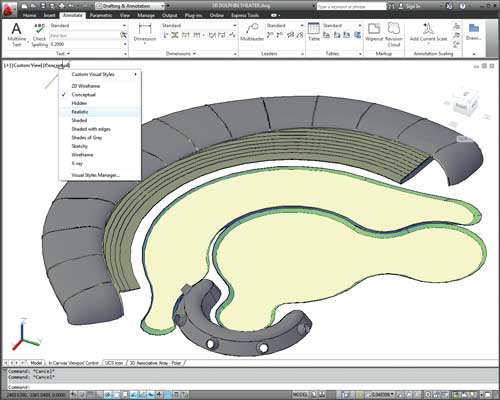
The in-canvas viewport controls that originally appeared in the Macintosh
version of AutoCAD 2011 have been added to AutoCAD 2012.
In the past, that might have meant a release relatively light on new features, much as AutoCAD 2009 offered few surprises beyond the now-familiar ribbon interface. But while really big enhancements may have to wait until next year, AutoCAD 2012 provides a wealth of welcome changes.
Borrowing from the Mac
Last fall, Autodesk quelled rumors when it released the first native Macintosh version of AutoCAD in nearly 20 years (see deskeng.com/articles/aabamx.htm). In addition to a totally Mac interface, AutoCAD 2011 for the Mac featured new in-canvas viewport controls. These same tools have now been added to AutoCAD 2012, enabling users to change viewport settings, views and visual styles by using tools that always appear in the upper-left corner of each viewport.
In-canvas control is further exploited in AutoCAD 2012 by the addition of new user coordinate system (UCS) icon functions. The UCS icon can now be selected and manipulated by using grips to quickly align the UCS with existing objects, including curved surfaces and solids. You can also right-click on the UCS icon to access additional UCS controls from a new shortcut menu, making it much easier to manipulate the coordinate system “particularly when working in three-dimensional space.
There are actually all sorts of subtle 3D changes. For example, a new Offset Edge tool lets you create an offset curve from a planar 3D face or surface. You can then use the Presspull tool to quickly add or remove the bounded area from a solid, and Presspull now repeats until you exit the command. In addition, when creating or modifying surfaces or solids, the software displays a preview of the resulting model, and how it will change before you commit to the change. So now, when you select a profile to create a lofted solid or surface, for example, an updated preview of the resulting object is displayed with each selection.
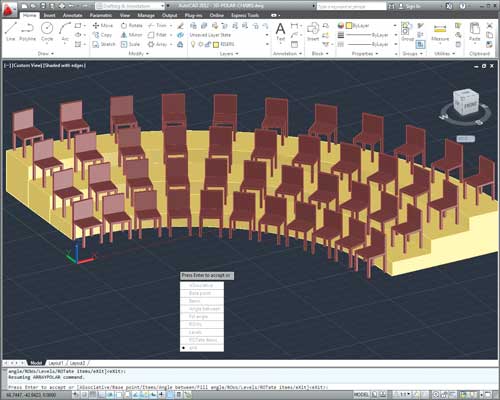
You can now create associative rectangular, polar or path arrays in 2D
or 3D, change the number of objects or array relationships, and even
replace arrayed objects.
The new preview also works when filleting, chamfering, blending or patching surfaces and solids, and there are new chain and loop selection options when modifying 3D models. The preview works when creating 2D fillets and chamfers, as well.
Another interface change is the new auto-complete function. In spite of improvements to its ribbon interface, many longtime AutoCAD users simply type to start commands. But as the software has evolved over more than 25 years, the number of commands and system variables has grown, making it difficult to remember them all. With auto-complete, as you type at the program’s command prompt or dynamic input field, AutoCAD 2012 displays a list of commands matching what you’ve typed thus far. You can then quickly select the command or system variable from the list.
Creating Associative Arrays
One particular addition to AutoCAD 2012 stands out as one of the biggest productivity improvement in years: AutoCAD can now create associative arrays.
Rather than simply making duplicate copies of selected objects, arranged in a rectangular or circular pattern, the old Array tool in AutoCAD has been replaced by three new commands for creating rectangular arrays, polar arrays or evenly distributing objects along a path formed by objects such as lines, arcs, polylines or helixes. Once the objects are positioned, you can modify them by changing the array relationships, such as increasing the number of rows or columns, changing the distance or angle between the copies, or modifying the individual items in the array. You can even change the source object and apply the changes to the rest of the items in the array.
The new array functionality isn’t limited to 2D, however. All three types of arrays can include multiple levels, and path arrays can follow 3D paths. Nor are associative arrays the only big 2D improvement. Multi-functional grips have been extended to more AutoCAD objects, such as lines, arcs and dimensions, as well as 3D faces, edges and vertices. When you hover the cursor over a grip, you now see a list of available options “and with dynamic input enabled, you can enter dimensional values.
AutoCAD 2012 also includes improved tangent and perpendicular object snap functionality. When grip editing, AutoCAD now finds osnap points to make objects tangent or perpendicular, and if AutoCAD’s inferred constraint function is toggled on, a corresponding geometric constraint is automatically applied.
There’s also a new array option when using the Copy tool to make multiple separate copies of objects at once, and AutoCAD can now create a fillet between splines. In fact, there are a number of enhancements to splines. For example, a new Blend tool creates a spline object between lines, arcs, polylines, splines and helixes, and includes an option to control the continuity between the two curves “very important if the resulting curve will be used as the basis for a 3D surface.
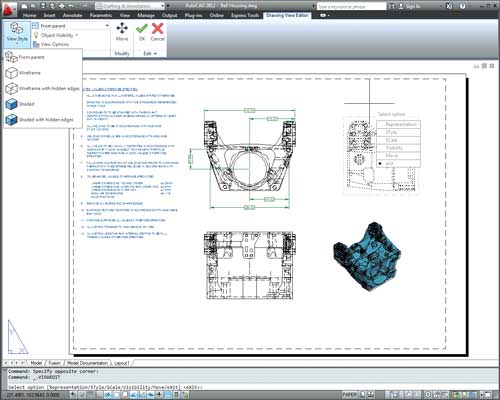
The new drawing views capability lets you quickly create orthographic
and projected views of 3D models, and control their view style and scale.
Manipulating 3D Models
AutoCAD 2012 represents some significant changes in the way users interact with three-dimensional models. In past releases, AutoCAD remembered the operations performed on solid objects. But in AutoCAD 2012, Solid History is toggled off by default. That means that users can no longer press the CTRL key to select and modify the properties of sub-objects that had been combined to form more complex solids. While users can certainly turn Solid History back on before creating 3D models, Autodesk’s intention is to move customers toward direct manipulation of non-history-based solids.
To accomplish that, AutoCAD 2012 automatically installs Autodesk Inventor Fusion, a plug-in that lets you edit 3D models using intuitive direct manipulation. When working on a 3D model, a single click opens the current drawing in Fusion. There’s no need to save and export the file. Once in Fusion, you can edit faces, edges and vertices, modify sub-objects, and add new features. After making the desired changes, a single click returns the updated model directly to AutoCAD “again without having to first save any files.
AutoCAD 2012 also includes the ability to import 3D models in a wide variety of formats, including CATIA, NX, Parasolid, Creo Elements/Pro, Rhino and SolidWorks. Depending on the size and complexity of the model, this can take quite some time. An Import icon displays on the status bar tray, and a notification bubble appears once the import is complete so that you can place the 3D model into your AutoCAD drawing.
The imported data is translated into native AutoCAD geometry, and inserted into the drawing as a block. Parts and assemblies in the original model are preserved and replicated as nested blocks. After importing, the model can be modified using standard AutoCAD tools.
Documenting Models with Drawing Views
In spite of its advances in 3D, AutoCAD is still used most often to produce 2D documentation. But those 2D drawings are frequently derived directly from 3D models by creating views of the model in separate paper space viewports. Dimensions and annotations would be created in model space on specific layers that were only visible in the appropriate viewport. If the model changed, everything would update, but users had to manage the individual viewports and layers, and set appropriate sizes for annotation objects.
AutoCAD 2012 introduces a totally new set of tools for documenting 3D models. If a drawing file contains a 3D model, users can switch to paper space and quickly create a base 2D drawing view of the 3D model. Once a base view has been placed, you can then create projected orthogonal and isometric views “and adjust the scale and appearance of those views. And if you make any changes to the original 3D model, AutoCAD displays a balloon notification: Clicking a link immediately updates the drawing views to reflect those changes.
Although drawing views can only be created in a paper space layout, they are not viewports but rather, a new Drawing View object. As a result, when you’re ready to add dimensions and notes, you do so in paper space rather than in model space, eliminating the hassle of creating viewports, controlling layers, and so on. But dimensioning model space objects in paper space can have unintended consequences. For example, if you’ve dimensioned drawing views and then update the 3D model, the dimensions will lose their associativity. You would then need to manually re-associate each dimension. In complex models, this could become quite tedious.
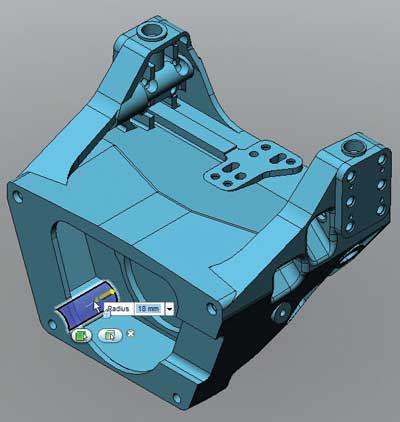
Users can open 3D models in Inventor Fusion, edit models
by directly manipulating faces, edges, vertices and features,
and return the modified model back to AutoCAD with a single
click.
Some New Tools May Need Some Work
There are several other new tools that may have more limited appeal. For example, when you first start AutoCAD, rather than the traditional “What’s New” screen, the software displays the Autodesk Exchange portal. Here you’ll find similar content, describing features in the new release. Autodesk Exchange is also where the program now displays Help whenever you press the F1 key. Autodesk Exchange is only available if you have a live Internet connection, although local help content can be displayed in a web browser when a web connection is unavailable.
By default, Autodesk Exchange appears whenever you start AutoCAD, although you can turn this off. In that case, you can still access Autodesk Exchange by clicking an Exchange button. In the future, Exchange may also host an online resource for add-ons, similar to the iTunes App Store, but this feature was not yet active at press time.
Autodesk Content Explorer is another new component that receives mixed reviews. This new AutoCAD plug-in appears to be a successor to DesignCenter, although both co-exist in this release. The first time you use Content Explorer, the software generates a Google-like index of DWG files so that you can locate and reuse blocks, layers, linetypes, styles, etc. Once the index has been created, you can easily find and filter content, then drag and drop results into the current drawing or open drawings by simply double-clicking. Users can add specific watch folders and also search for content on Autodesk Seek. You can also use Content Explorer to search across a local area network, but to do so, you must install the Content Service on the networked machines “something that may require the help of IT support staff.
Other Subtle Changes
As we’ve come to expect, the third release in a DWG series also includes a host of small improvements, what Autodesk often refers to as “fit and finish.” For example, there are small improvements to the ribbon that make it easier to define and insert blocks. AutoCAD 2012 also starts up faster and responds more quickly when switching between ribbon tabs.
You can now select an object and nudge it a few pixels in orthogonal directions by pressing the CTRL key and the appropriate arrow key. In the past, the Quick Properties palette, if enabled, would appear when you selected an object, so many users turned this off. Now, you can turn Quick Properties off and still display this useful palette whenever you double-click on most objects.
AutoCAD’s group functionality was another feature that users tended to ignore because it could be tedious. Groups are now streamlined and have their own simplified panel on the ribbon.
When selecting objects, many users forget that there are selection modes other than window and crossing window. Now, when you pick an empty spot in a drawing, AutoCAD 2012 reminds you that you can also use a window polygon, a crossing polygon or a fence. And when AutoCAD’s snap mode is enabled, the cursor no longer jumps to snap points when you’re simply selecting objects.
AutoCAD 2012 includes a layer enhancement that lets you freeze specified layers in all viewports except the current viewport, improvements to multi-leaders, and the inclusion of a Delete Duplicate command as a core function rather than relying on an Express Tool. Other enhancements include:
- improved raster and DGN file support;
- improvements to AutoCAD’s installation process;
- improvements to the tools used to migrate customizations made to an older version to the new release; and
- improvements to AutoCAD’s point cloud capabilities.
We’ve got to hand it to Autodesk. Rather than simply being a grab bag of functions that somehow didn’t make it into previous releases, AutoCAD 2012 offers a lot of truly useful new features. By combining these with improved performance, AutoCAD 2012 is another must-have release.
AutoCAD LT 2012 With each new release of its flagship, Autodesk also adds new features to AutoCAD LT, the lower-cost 2D alternative to AutoCAD. Once again, AutoCAD LT 2012 benefits from new features in AutoCAD 2012 “and also gains some functionality once reserved exclusively to AutoCAD. For example, AutoCAD LT 2012 shares the same Autodesk Exchange interface for help and what’s new, improved performance, and migration tools. AutoCAD LT 2012 also benefits from the same new auto-complete functionality and the new associative rectangular, polar and path arrays. Users can even create three-dimensional arrays by including multiple levels “in spite of the fact that AutoCAD LT still lacks tools like the ViewCube for easily viewing 3D models. The only practical way to reorient a 3D model in AutoCAD LT is by typing the Viewpoint command. AutoCAD LT 2012 also gains the new Blend command, the ability to nudge objects, the improved multi-functional grip capabilities, and the double-click Properties palette functions added to AutoCAD 2012. The same new Groups panel also appears in AutoCAD LT’s improved ribbon, and LT 2012 incorporates similar fillet and chamfer previews and improvements to multi-leaders, splines and layers. Perhaps the biggest function to finally migrate from AutoCAD to AutoCAD LT is the Sheet Set Manager. AutoCAD users have long been able to create sheet sets to help organize sets of drawings, create layout views, and reduce the steps needed to publish documents. That capability has finally made its way into AutoCAD LT 2012, making it a more equal partner in the development of 2D documentation. There also remains one other subtle difference between AutoCAD and AutoCAD LT: While AutoCAD still includes the MLine command, which creates largely disfavored multi-line objects that require their own editing tools, AutoCAD LT has a DLine command, which simply creates parallel line objects that can then be edited using standard commands. With its two-dimensional functionality now nearly equal to AutoCAD itself, AutoCAD LT 2012 should meet the needs of anyone looking to add adjacent seats, or as a low-cost 2D-only alternative to AutoCAD. It’s no wonder AutoCAD LT remains the top-selling 2D drafting application.
|
David Cohn is the technical publishing manager at 4D Technologies. Hes a contributing editor to Desktop Engineering and also does consulting and technical writing from his home in Bellingham, WA. The author of more than a dozen books has been benchmarking PCs since 1984. You can contact him via email at [email protected] or DSCohn.com.
For more information:
AutoCAD 2012 pricing:
Full system: $3,995; annual subscription: $450
Upgrade from AutoCAD 2011: $595; from AutoCAD 2010: $1,195; from AutoCAD 2009: $1,795
AutoCAD LT pricing: $1,200 MSRP
System Requirements:
Operating System: Windows 7, Windows Vista (SP2 or later),
or Windows XP (SP3 or later); 64-bit or 32-bit
CPU: Intel Pentium 4 or AMD Athlon dual-core 1.6GHz or greater (3.0GHz or greater recommended for Windows 7 or Vista or 3D modeling; AMD64 or Intel EM64T processor for 64-bit version)
Memory: 2GB RAM (1GB for AutoCAD LT)
Disk Space: 2GB free disk space for installation (1.4GB for AutoCAD LT)
Video: 1024x768 VGA with true color minimum (for 3D modeling: 1280x1024 with 128MB video RAM or greater, Pixel Shader 3.0 or greater, Microsoft Direct3D-capable workstation-class graphics card)
Subscribe to our FREE magazine, FREE email newsletters or both!
Latest News
About the Author
David Cohn is a consultant and technical writer based in Bellingham, WA, and has been benchmarking PCs since 1984. He is a Contributing Editor to Digital Engineering, the former senior content manager at 4D Technologies, and the author of more than a dozen books. Email at [email protected] or visit his website at www.dscohn.com.
Follow DE






